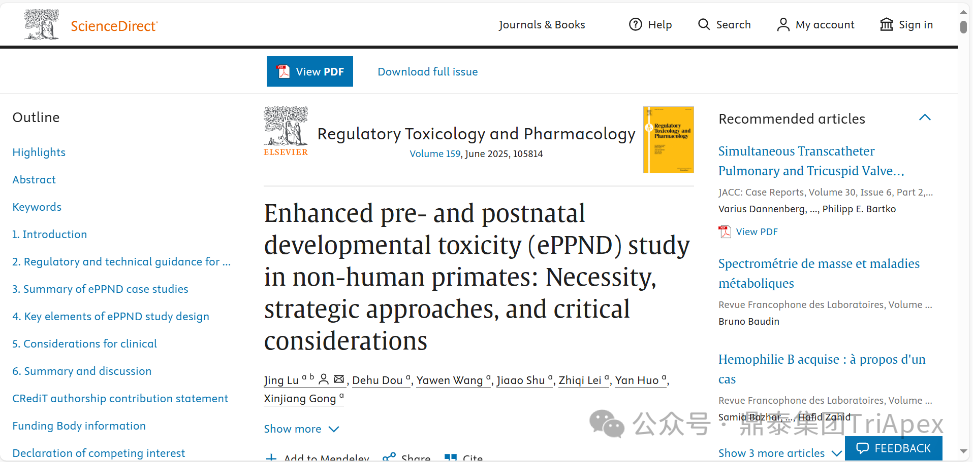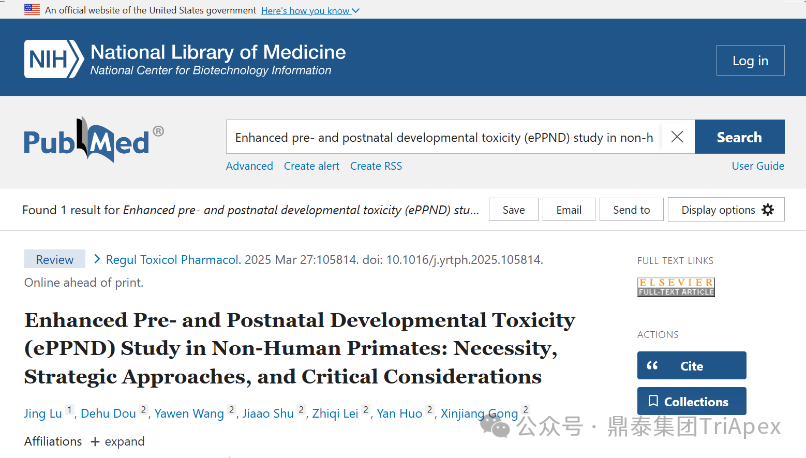


TriApex: Major Breakthrough in Non-Human Primate Reproductive and Developmental Toxicity Research Platform


The safety of medications for pregnant women and women of childbearing potential (WOCBP) has long been a mutual concern for both the pharmaceutical industry and regulatory agencies. In recent years, as many antibody-based therapies have advanced to the pivotal clinical trials or Biologics License Application (BLA) stage, non-clinical safety studies have increasingly concentrated on assessing reproductive risks.
In accordance with the ICH S6(R1) and ICH S5(R3) guidelines, when NHP are the only pharmacologically relevant species, particularly for biologics, an ePPND study is recommended to identify the risk of their reproductive and developmental toxicity. Therefore, a well-designed ePPND study and robust NHP reproductive and developmental operational techniques are crucial for meeting the evolving industry standards, current R&D advancements, and compliance with multinational regulatory requirements.
Abstract
In order to identify reproductive and developmental concerns and guarantee drug safety in populations including pregnant WOCBP, non-clinical developmental and reproductive toxicity (DART) studies are essential for innovative drug development. NHPs remain the sole scientifically-validated model for DART experiments since they are the only pharmacologically relevant species for the majority of antibody-based biopharmaceuticals.
The rigorous design criteria, complicated protocols, prolonged time constraints and high expenditures of these research present substantial challenges. Conducting a single, well-designed NHP study, in which the test substance is administered from gestational day 20 until delivery (enhanced Pre- and Postnatal Developmental study, or ePPND study), it is a more scientific and efficient approach than performing independent Embryo-Fetal Developmental (EFD) and Pre- and Postnatal Developmental (PPND) studies. This review highlights the scientific rationale for NHP-based ePPND studies as mandated by major regulatory agencies, discusses advanced methodologies, key challenges (including endpoint selection, experimental design optimization, and data interpretation with case examples), and offers guidance or decision framework regarding the ePPND design across antibody-based therapeutics for researchers and regulatory agencies.
Highlights
This paper offers a succinct overview of key aspects of ePPND studies under animal ethics and technical challenges.
By integrating regulatory requirements with empirical insights from approved therapeutics, this article offers an in-depth technical analysis of ePPND study design, encompassing grouping and size, dosage, administration routes, dosing periods and frequency, observation period and terminal points, exposure and parameters.
It conveys the research strategies by summarizing representative ePPND studies supporting FDA application, along with horizontal and vertical analysis of characteristic cases to guide drug development.
This work provides an in-depth analysis of the conditions, necessity, and timing for conducting ePPND studies across various clinical requirements.
It explores the significant considerations of ePPND study results regarding extrapolation from non-clinical to clinical trials in special populations.
The establishment of a verified GLP-compliant NHP ePPND research platform has become particularly important as the development of antibody-based therapeutics progresses into the pivotal clinical trials and BLA phases. TriApex leverages its proprietary expertise through systematic analysis of extensive research experience, technical standards, regulatory guidelines, and pertinent study cases. Over three years of dedicated efforts, we have established a technically operable NHP reproductive and developmental toxicity research platform, achieving technical parity with international benchmarks through continuous process optimization.
The launch of this platform represents a significant advancement for TriApex in the field of developmental and reproductive toxicity study. TriApex team has seamlessly integrated their profound professional knowledge with the practical experience, and conducted ePPND studies to investigate DART of biologics in order to support the global BLA of novel biotherapeutics in its well managed GLP laboratory.

At present, our platform has accumulated a wealth of comprehensive background data, constructed an industry-aligned benchmark database and carrying out thorough comparisons with the ePPND studies of successfully marketed products. Beyond offering robust support for ongoing research, these data serve as crucial references for advancing industry standards. Through extensive data mining, our team has improved the scientific rigor and validity of the research, further refining experimental design, and acquiring deeper insights into the inherent challenges in ePPND implementation framework.
The Practice of Integrated Service Philosophy
Adhering to a holistic integrated service philosophy, TriApex is dedicated to providing our clients complete and superior R&D empowerment services. An exemplary application of this philosophy in action is the establishment of the ePPND research platform in NHPs. Utilizing the extensive resources of Kunming Biomed International Ltd. (KBI) and Hainan Yaling Biotechnology Co., Ltd. in NHPs, the platform combines animal resource expertise with advanced research skills, ensuring study effectiveness and data reliability.


Future Prospects
TriApex is dedicated to advancing research on NHP reproductive and developmental toxicology by strategically focusing on enhancing platform, operational technology, and service quality. As the landscape of therapeutic innovation continues to evolve, our mission is to provide cutting-edge, reliable, and impactful technical and scientific support for global pharmaceutical research and development.
供稿:生殖发育毒理中心


































































































































